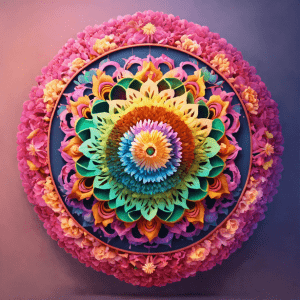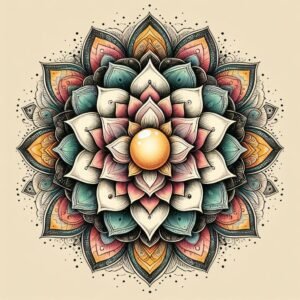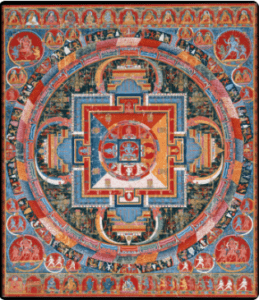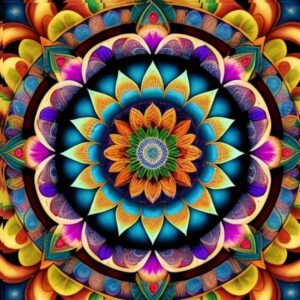Table of Contents
ToggleThe Spiritual Power of Mandalas: Unveiling Sacred Symbols

In the symmetrical dance of circles, squares, and intricate patterns, mandalas emerge as portals to the spiritual realm—a visual tapestry that transcends the boundaries of culture, time, and belief systems. The creation and contemplation of mandalas have been revered across centuries and civilizations as a sacred practice, inviting individuals to embark on a journey of self-discovery, meditation, and connection to the divine. Join us on an exploration of the spiritual power of mandalas, where the act of crafting these intricate designs becomes a transformative and meditative journey toward the essence of the sacred.
Unveiling the Essence of Mandalas
- Sacred Geometry in Art: At the heart of mandalas lies the beauty of sacred geometry—an ancient concept that explores the interconnectedness of all things through geometric patterns. Mandalas often incorporate symbols such as circles, squares, triangles, and spirals, reflecting the inherent order and harmony that underlie the fabric of the universe.
- Universal Symbolism: Mandalas serve as universal symbols found in various spiritual traditions, including Hinduism, Buddhism, Christianity, and Native American spirituality. The word “mandala” itself is derived from the ancient Indian language of Sanskrit, meaning “circle.” Across cultures, mandalas are seen as representations of wholeness, unity, and the cyclical nature of existence.
- The Circle of Unity: The circle, a fundamental element of mandalas, symbolizes unity, eternity, and the cyclical nature of life. It represents the totality of existence and serves as a reminder of the interconnectedness of all things. In the creation of a mandala, the circular form becomes a canvas for the expression of the infinite within the finite.
Crafting Mandalas: A Spiritual Practice
Creating mandalas can be a deeply meditative and therapeutic practice. Here’s a simple guide to get started:
Set the Intention: Before you begin, set a clear intention for your mandala, whether it’s for healing, manifestation, or self-reflection. Choose Your Materials: Select your preferred medium, such as paper and pen, colored pencils, or digital drawing tools. Start from the Center: Begin drawing from the center of your mandala, allowing the design to unfold naturally. Follow the Flow: Let go of any expectations and allow the mandala to evolve organically as you add layers and patterns. Reflect: Take a moment to reflect on your creation once it’s complete. Notice any insights or emotions that arise.

- Meditative Creation: Crafting a mandala is a meditative process that invites individuals into a state of focused awareness. Whether through drawing, painting, or using digital tools, the act of creating a mandala becomes a journey inward. The repetition of patterns and the rhythmic flow of design serve as a gateway to a contemplative space.
- Intention and Mindfulness: Each stroke and pattern in a mandala holds intention and meaning. The process of creation is a mindful practice that involves a deep connection to the present moment. As individuals engage with the intricate details of the mandala, they cultivate a heightened sense of awareness and focus.
- Symbolic Elements: Mandala designs often incorporate symbolic elements that hold personal or cultural significance. Common symbols include the lotus flower, representing purity and enlightenment, or the sacred geometry of the Flower of Life, symbolizing the interconnectedness of all living things. These symbols infuse the mandala with layers of meaning and spiritual depth.
Modern Mandalas: Bridging Tradition and Innovation
- Digital Mandalas: In the digital age, the creation of mandalas has extended into the realm of technology. Digital tools allow for the intricate design of mandalas on virtual canvases, opening new avenues for creative expression and exploration of sacred geometry.
- Mandalas in Therapy: The therapeutic benefits of mandalas have been embraced in the field of psychology. Art therapists use mandala creation as a means of self-expression, stress reduction, and exploration of the inner psyche. The process of crafting a mandala becomes a visual narrative of one’s thoughts and emotions.
- Global Artistic Expression: Contemporary artists around the world continue to explore and reinterpret the concept of mandalas in their work. From paintings and drawings to intricate installations, the artistic expression of mandalas serves as a bridge between tradition and innovation, inviting viewers to engage with the spiritual essence of these captivating designs.

Mandalas as Meditation Tools
- Contemplative Focus: Contemplating a mandala is a form of meditation that guides individuals toward a state of contemplative focus. The intricate patterns draw the gaze inward, creating a meditative space for reflection, introspection, and connection to the spiritual dimensions of the self.
- Mindful Coloring: The rise of adult coloring books featuring mandala designs attests to the therapeutic and meditative qualities of coloring mandalas. The act of choosing colors, filling in patterns, and staying within the lines becomes a form of active meditation, promoting relaxation and stress relief.
- Transformational Journey: Mandalas are not merely artistic creations; they are transformative gateways. Engaging with mandalas as meditation tools can lead individuals on a journey of self-discovery, healing, and spiritual awakening. As the mind focuses on the harmonious patterns, a sense of inner balance and tranquility may unfold.
The Chakra Connection

- Energy Centers of the Body: In many spiritual traditions, mandalas are associated with the chakras—energy centers within the body. Each chakra is linked to specific qualities and attributes, and the corresponding mandalas serve as visual representations of the energetic flow within these centers. Mandalas become tools for balancing and harmonizing the subtle energies of the body.
- Chakra Mandalas: The use of chakra mandalas involves creating or contemplating designs that align with each chakra’s energy. For example, a mandala with vibrant red hues may be associated with the root chakra, symbolizing grounding and stability, while a mandala with soothing blue tones may align with the throat chakra, representing communication and expression.
Benefits of Mandala Meditation
Mandalas have been associated with various healing benefits
Psychological Benefits
- Promotes relaxation and reduces anxiety
- Enhances cognitive function and problem-solving skills
- Facilitates emotional expression and processing
Emotional Healing
- Provides a safe space for self-reflection and introspection
- Encourages the release of pent-up emotions and traumas
- Promotes a sense of empowerment and inner peace
Incorporating Mandalas into Daily Life
Mandalas can be integrated into various aspects of daily life:
- Decorative Purposes: Use mandalas as decorative pieces in your home or workspace to promote a sense of harmony and balance.
- Wearable Mandalas: Wear mandala jewelry or clothing as reminders of your spiritual journey and connection to the universe.
- Mandalas in Yoga and Meditation Practices: Use mandalas as focal points for meditation or as inspiration for your yoga practice.

Closing Reflections
In the intricate patterns of mandalas, we find a visual symphony that transcends cultural, religious, and temporal boundaries. Whether created as a spiritual practice, meditative tool, or artistic expression, mandalas serve as timeless gateways to the divine—a fusion of geometry, symbolism, and intention that invites individuals to embark on a transformative journey of self-discovery and connection to the sacred.
May the creation and contemplation of mandalas be a source of inspiration, inner harmony, and spiritual awakening. In the circular dance of lines and colors, may each stroke be a step toward the center of the mandala—a center that mirrors the essence of the self and the boundless dimensions of the divine.
